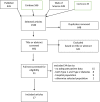Incidence of sight-threatening diabetic retinopathy in people with Type 2 diabetes mellitus and numbers needed to screen: a systematic review
- PMID: 30677170
- PMCID: PMC6767411
- DOI: 10.1111/dme.13908
Incidence of sight-threatening diabetic retinopathy in people with Type 2 diabetes mellitus and numbers needed to screen: a systematic review
Abstract
Aim: To investigate the incidence of sight-threatening diabetic retinopathy in Type 2 diabetes mellitus.
Background: In most countries, yearly or biennial screening intervals for diabetic retinopathy in people with Type 2 diabetes are recommended. Fewer screening sessions reduce the effort required of people with Type 2 diabetes and reduce healthcare costs.
Methods: We conducted a search of PubMed, Embase, Web of Science and the COCHRANE Library for studies published betweeen 1 January 2000 and 1 January 2017. Eligible studies were those that included general populations of >100 people with Type 2 diabetes mellitus. Additional study population criteria were absence of moderate diabetic retinopathy or more severe diabetic retinopathy at last screening session and at least two gradable retinal screening sessions. Outcomes of interest in the included studies were moderate and severe non-proliferative diabetic retinopathy (R2), proliferative diabetic retinopathy (R3) or maculopathy (M1), collectively known as sight-threatening or referable diabetic retinopathy.
Results: A total of 17 studies were included. In people with Type 2 diabetes without or with only mild diabetic retinopathy at baseline, the average incidence rates of sight-threatening diabetic retinopathy were ~1 per 100 person-years and ~8 per 100 person-years, respectively. The average numbers needed to screen to detect one case of sight-threatening diabetic retinopathy were 175 and 19 in people without and with mild retinopathy at last screening, respectively.
Conclusion: In people with Type 2 diabetes without retinopathy at last screening, the incidence of severe sight-threatening retinopathy at the subsequent screening session was low. In people with mild retinopathy, progression to sight-threatening diabetic retinopathy was nearly 10-fold higher. This review supports lengthening of the screening interval of patients with Type 2 diabetes without retinopathy at last screening session.
© 2019 The Authors. Diabetic Medicine published by John Wiley & Sons Ltd on behalf of Diabetes UK.
Figures
References
-
- Early Treatment Diabetic Retinopathy Study Research Group . Fundus photographic risk factors for progression of diabetic retinopathy. ETDRS report number 12. Ophthalmology 1991; 98: 823–833. - PubMed
-
- Harding S, Greenwood R, Aldington S, Gibson J, Owens D, Taylor R et al Grading and disease management in national screening for diabetic retinopathy in England and Wales. Diabet Med 2003; 20: 965–971. - PubMed
-
- Song H, Liu L, Sum R, Fung M, Yap MK. Incidence of diabetic retinopathy in a Hong Kong Chinese population. Clin Exp Optom 2011; 94: 563–567. - PubMed
Publication types
MeSH terms
LinkOut - more resources
Full Text Sources
Medical


